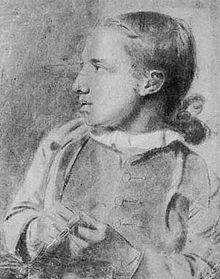James Stuart (1713–1788)
| James Stuart | |
|---|---|

James Stuart as a child, self-portrait
|
|
| Born | 1713 London |
| Died | 2 February 1788 London |
| Nationality | Scottish |
| Occupation | Architect |
| Buildings | Interiors Spencer House, London Garden Buildings Shugborough Hall All Saints' Church Nuneham House |
James "Athenian" Stuart (1713 – 2 February 1788) was a Scottish archaeologist, architect and artist, best known for his central role in pioneering Neoclassicism.
Stuart was born in 1713 in Creed Lane, Ludgate Street, London, to a Scottish sailor who died when he was young. Proving a talented artist while his family was in poverty, he was apprenticed to a fan painter to support the family financially. However, in around 1742, he was able to travel to Italy (albeit on foot) for his artistic improvement, working there as a cicerone and a painter, learning Latin, Italian and Greek, and studying Italian and Roman art and architecture. There he produced his first major work, his illustrated treatise on the Egyptian obelisk of Psammetichus II within A. M. Bandini's De obelisco Caesaris Augusti, and met Nicholas Revett, a young East Anglian nobleman and amateur architect on his Grand Tour.
In 1748 Stuart joined Revett, Gavin Hamilton and the architect Matthew Brettingham the younger on a trip to Naples to study the ancient ruins and, from there,they travelled through the Balkans (stopping at Pula) to Greece. Visiting Salonica, Athens, and an Ionic temple on the River Ilissus among others, they made accurate measurements and drawings of the ancient ruins.
Stuart and Revett returned to London in 1755 and published their work, The Antiquities of Athens and Other Monuments of Greece, in 1762. There were more than five hundred subscribers to its first volume and, although few of the subscribers were architects or builders, thus limiting its impact as a design sourcebook, it later helped fuel the Greek Revival in European architecture. Its illustrations were among the first of their kind and the work was welcomed by antiquaries, scholars, and gentleman amateurs. William Hogarth satirised its fastidious depiction of architectural detail in his 1761 engraving Five Orders of Periwigs.
...
Wikipedia
